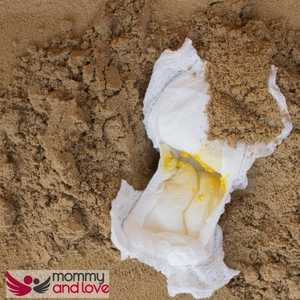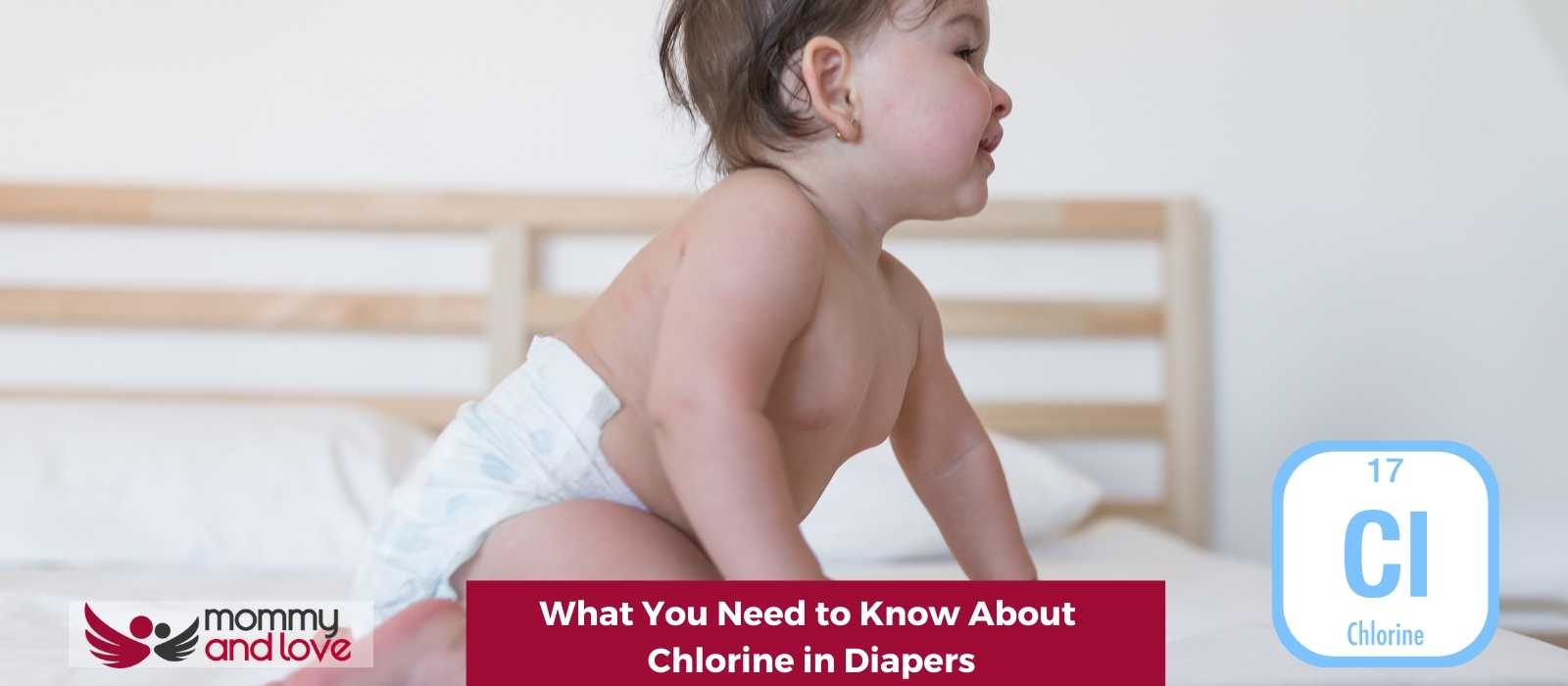If you are a parent, then you have probably had to deal with chlorine in disposable diapers at some point. This is a topic that can be confusing for many parents, so we wanted to provide some information on it in this blog post.
Chlorine is often used in diapers to help kill bacteria and keep them clean. However, it can also cause skin irritation for some babies.
In addition, the super absorbent core and inner lining which is made from wood pulp have gone through chlorine bleaching to whiten diaper material.
In this blog post, we will discuss the pros and cons of using chlorine dioxide in a disposable diaper, and we will also provide some tips on how to deal with any skin irritation that may occur.
Do Diapers Contain Chlorine?

You might be wondering why they put chlorine in disposable diapers. The answer is simple: to keep them clean.
However, this comes at a cost, especially during the bleaching process.
Most people don’t think about what’s in their disposable diapers, but it’s important to know what ingredients are in them. Chlorine is one of the most common chemicals found in diapers. It’s used to bleach the fabric and make it white.
Why Is Chlorine in Most Disposable Diapers Bad for the Baby?
One of the main health concerns about chlorine is that it is a toxic gas that can irritate the lungs and cause difficulty breathing. It can also be absorbed through the skin, which can lead to serious health problems.
Babies are particularly vulnerable to the effects of chlorine because their skin is thinner and more absorbent than adults. Additionally, babies typically wear diapers for long periods of time, which increases their exposure to the chemical.
There are a number of health risks associated with chlorine exposure, including cancer, reproductive damage, and immunotoxicity. Additionally, chlorinated water has been linked to diaper rash and other skin irritation in infants.
Given the serious risks involved, it is important to avoid using products that contain chlorine in diapers. There are a number of alternative products available that are just as effective but do not contain this harmful chemical.
Why Is Chlorine Bad for the Environment?

Chlorine is a highly reactive element, and when it is released into the environment, it can cause serious harm.
The Environmental Protection Agency (EPA) has classified chlorine as a hazardous air pollutant, and exposure to chlorine can cause a range of health problems, including respiratory irritation, coughing, and wheezing.
A study published in the journal Environmental Health Perspectives suggested that chlorine also damages the environment. When chlorine is released into the air, it reacts with other chemicals to form ozone, a pollutant that can cause smog and respiratory problems. Chlorine also contributes to the formation of acid rain, which can damage crops, trees, and aquatic life.
Should You Buy Totally Chlorine-Free Disposable Diapers?
The answer to this question depends on a few factors. First, you need to consider your budget. Totally chlorine-free (TCF) disposable diapers are typically more expensive than traditional diapers. Second, you need to think about your baby’s skin. If your baby has sensitive skin, totally chlorine-free diapers may be a good option for you. Finally, you should consider your own personal preferences. If you are concerned about the environment, diapers that are elemental chlorine-free may be the right choice for you.
If you decide to purchase TCF diapers, there are a few things you should keep in mind. First, make sure to read the labels carefully. Not all total chlorine-free diapers are created equal. Some may be made with recycled materials, while others are not. Second, these diapers may not have a super absorbent core (made from wood pulp) as conventional diapers. This is something you should keep in mind if your baby is a heavy wetter. Finally, these diapers may not be available in all sizes. If you have a newborn or a toddler, you may not be able to find totally safe diapers that fit your child.
What Toxic Chemicals Should Be Avoided in a Disposable Diaper?
Babies spend a lot of time in diapers and are exposed to the chemicals in many disposable diapers. Some of these chemicals can be harmful to their health. Keep in mind that diaper companies are not required to list the materials and chemicals of their product. With that said, here are some of the most toxic chemicals found in your baby’s diaper and what you can do to avoid them.
Some of the most dangerous chemicals found in scented diapers with a wetness indicator are phthalates, dioxins, and VOCs. Phthalates are used to soften plastics and are known to disrupt hormones. The outer lining of most diapers is made from polyethylene film which is a kind of plastic. Dioxin is a human carcinogen that can cause cancer, birth defects, and other health problems.
Volatile organic compounds (VOCs) are chemicals that can easily become vapors or gases. They’re found in many common household products, including diapers. VOCs can cause a variety of health problems, including respiratory irritation, headaches, and dizziness.
According to the World Health Organization, sodium polyacrylate is a gel-like substance that’s often used as a super absorbent polymer (some are made with wood pulp) in diapers. The super absorbent polymer makes them absorbent. However, it’s also been linked to toxic shock syndrome (TSS). TSS is a rare but potentially fatal condition that’s caused by bacterial infections. Symptoms include fever, rash, and low blood pressure.
Polypropylene and Polyethylene
Most disposable diapers contain polypropylene and polyethylene which are the two main types of plastic used in diapers, and each has its own benefits.
Polypropylene is a strong and lightweight plastic that’s often used in packaging and inner lining. It’s also moisture-resistant, so it helps keep diapers dry. Polyethylene, on the other hand, is a softer plastic that’s often used in food packaging. It’s less likely to cause skin irritation and is more comfortable for babies to wear.
While they both have their benefits, there are also some potential risks associated with them.
One of the main concerns with polypropylene and polyethylene is that they may contain hazardous chemicals that could leach into a baby’s skin. Additionally, both of them are not biodegradable, so they could potentially pollute the environment.
Dyes
Dyes in diapers can be bad for babies for a few reasons. First, some dyes can be toxic if they’re ingested. Second, dyes can cause skin irritation or allergic reactions. And finally, dyes can transfer to clothing and bedding, which can be difficult to remove.
Generally, diaper dyes are considered harmless. However, in some extremely rare cases, some of them have caused allergic reactions in infants.
Dyes can be discovered on the inside and outside of the diaper. The diaper’s colors and designs are what set it apart.
Some colors have the potential to cause allergic reactions and include harmful compounds and heavy metals.
Despite the fact that diaper manufacturers normally avoid stating what they use to color their diapers, the majority of disposable diapers available these days appear to be created with pigments and inks that have good safety profiles. For what it’s worth, none of the most hazardous dyes, such as dispersion dyes, are now used in disposable diapers.
Artificial Fragrances and Scents
To assist disguise undesirable odors, some disposable diaper brands add perfume aroma to their diapers.
Perfume aroma is a synthetic chemical blend that is one of the top allergens capable of provoking asthma episodes or eczema. Because fragrance formulas are considered a proprietary trade secret, diaper makers are exempt from disclosing the individual chemicals that contribute to the scents and fragrances of the diaper.
So, if you use a product containing synthetic fragrance, including scented diapers, you increase your risk of rashes and respiratory (and other) problems.
And because the FDA does not control the use of the phrase “fragranced” to describe diapers, diaper makers are not required to inform us exactly what they use, and the term is frequently used to conceal a slew of additional chemicals.
Diaper brands may be using hundreds of chemicals to create these artificial fragrances, some of which may be allergens, irritants, or even carcinogens, and the worst part of it is the disposable diaper industry is getting away with it. These allergens and irritants have the potential to cause diaper rashes, skin rashes, and even respiratory issues.
To avoid these harmful chemicals, you should look for a particular diaper that is made without harmful chemical pesticides. You can also look for organic or natural diapers. These types of diapers are made without harmful chemicals and are better for your baby’s health. Remember that not all diapers are created equal and in our search for the best disposable diapers we need to be aware of their materials.
What to Look For in Chlorine-Free Diapers?

When it comes to the best non-toxic diapers, there are a few things you should keep in mind. First, look for dye-free diapers.
This will help to avoid any irritation that can be caused by dyes. Next, the diaper’s absorbent core should be chemical-free and made from natural materials.
This will help to keep your baby dry and comfortable. Finally, make sure the diapers you select are comfortable for your baby. This will help to avoid any leaks or other problems. By following these tips, you can be sure to find the best elemental chlorine-free disposable diapers for your baby.
Or you could also start cloth diapering with a green diaper to avoid all the chemicals found in conventional diapers.
How Can You Save Money on Chlorine-Free Disposable Diapers?
There are a few things you can do to save money on non-toxic disposable diapers. One is to buy them in bulk. You can usually find good deals on sites like Amazon. Another way to save money is to use reusable diapers. Cloth diapers can be reused over and over again, which saves you money in the long run. Finally, you can try to find coupons or discounts for safe diapers. Many companies offer coupons or discounts for first-time customers.
What Are Signs of Allergic Skin Reactions to Chlorine in Diapers?
There are a few signs that may indicate your baby is allergic to the chlorine in their diapers. These include red, irritated skin around the diaper area (diaper rash), excessive crying and discomfort, and rashes. If you notice any of these signs, it’s important to take them seriously. Allergic reactions can be very serious, so it’s always best to err on the side of caution, especially when your baby’s health is involved.
Conclusion
Chlorine is a common chemical that’s used in many products, including diapers. While it’s generally considered safe, there are some risks associated with chlorine exposure such as diaper rashes. If you’re concerned about the safety of your baby, there are a few things you should keep in mind. You can purchase chlorine-free diapers, but they may not be as absorbent as traditional diapers. You can also try to save money by using cloth diapers or looking for coupons and discounts. By following these tips, you can ensure that your baby is safe and comfortable.

This article was written by: Gian MIller – Full-Time Writer, Baby Whisperer & Dad of 3.
Gian spends a lot of his time writing. A self-proclaimed baby whisperer, Gian has been through it all with his own children and is passionate about sharing his hard-won wisdom with other parents. When he’s not writing or changing diapers, you can find him playing the guitar or watching baseball (or preferably both at the same time).




